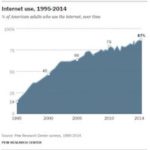Marketing Digital Horizon: The Web at 25 and Beyond

Sir Tim Berners-Lee
A few of our readers may a recall a time before a computer and Internet access were standard equipment for marketing. Today, our daily work—indeed the communications fabric of society—is online and interconnected.
Less than 20 years ago, almost half of US adults (42 percent) had never heard of the Internet, Pew Research says. But today it’s mainstream; 87 percent of US adults use the Internet. It was 25 years ago this week computer scientist Sir Tim Berners-Lee ignited the “information management” events that created the World Wide Web.
In common parlance, “Internet” and “World Wide Web” or “Web” are interchangeable terms. But, not to put too fine a point on it all, there is a technical difference. Strictly speaking, “The Internet is a system of rules (protocols) that enable computer networks to communicate with each other,” Pew explains. “The Web is a service that uses the network to allow computers to access files and pages that are hosted on other computers.” Drilling down further are various applications that facilitate specific online functions such as email, file sharing, etc.
Regardless of the labels, what we have today—in our home, on our desk, and in our shirt pocket—is an amazing communications capability, described by the World Wide Web Foundation: “The Web has changed the world, arguably becoming the most powerful communication medium the world has ever known.
“The Web has fundamentally altered the way we teach and learn, buy and sell, inform and are informed, agree and disagree, share and collaborate, meet and love, and tackle problems ranging from putting food on our tables to curing cancer.”
As technology accelerates, today’s practical applications for healthcare marketing, advertising and public relations become incredibly powerful and effective. Broadband and WiFi connections, and computer devices—from desktop to Smartphone—are nearly ubiquitous.
Marketing and the digital horizon
In the near future, hardware, user capabilities, and the less-obvious software advances are leading us to rapid and dramatic impacts in marketing and communications. Even more than previously, “Composition and character of people’s social networks [are becoming] important channels of discovery and learning, trust and influence,” predicts Lee Rainie, Director of the Pew Research Center’s Internet Project.
The Project’s latest research, Marketing in the Networked Age looks deeply at present and future Internet use, mobile connectivity, and social media, and what the findings mean for marketers. “Organizations can become media companies themselves,” in one example, acting as “’helper nodes’ in people’s networks. The expanding volume of online healthcare information—originated by doctors and hospitals, and that shared online among prospective patients via social media—is the current iteration.
 Computer technology, connectivity devices and Internet access have converged to be mainstream among US adults, and whatever availability gap remains is rapidly disappearing. Present day and near-term trends are personalized and individualized.
Computer technology, connectivity devices and Internet access have converged to be mainstream among US adults, and whatever availability gap remains is rapidly disappearing. Present day and near-term trends are personalized and individualized.
Target Audience of One: The pervasive Internet is increasingly personal, and capabilities to direct messages will continue to refine to one-to-one precision.
From Portability to Wearability: Undeniably popular Smartphones (more correctly pocket computers) have 56 percent of the mobile market. Sales of smart glasses, smart watches and wearable fitness trackers--all web enabled--is "expected to reach 64.0 million units in 2017,” analyst firm Berg Insight predicts.
From Fitness Tracking to Total Health: Advances in sensor technology empower much more than monitoring steps walked in a day. Corporate giants such as Google, Apple and others are looking for the next-level business sweet spot where wearable tech intersects with healthcare and medical devices.
A Doctor in Your Pocket: Can a wearable total wellness and healthcare delivery device—complete with personal health history and medical records onboard—be available soon? Will wearable come to mean implanted?
Educated, Informed and Empowered Consumer: The educational power of the Internet will continue to raise the level of consumer awareness. Customer/patient expectations will continue to require a higher level of sophistication and personalization in marketing and advertising. The communications system will include the person, the provider, and "onboard" devices and data.
For more on this topic, see the Pew Report: The Web at 25 in the US and related reports, and Playing the Numbers: 20 Reasons You Need a First Class Internet Plan.








